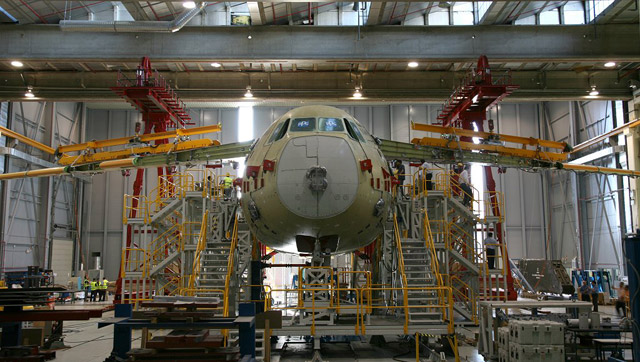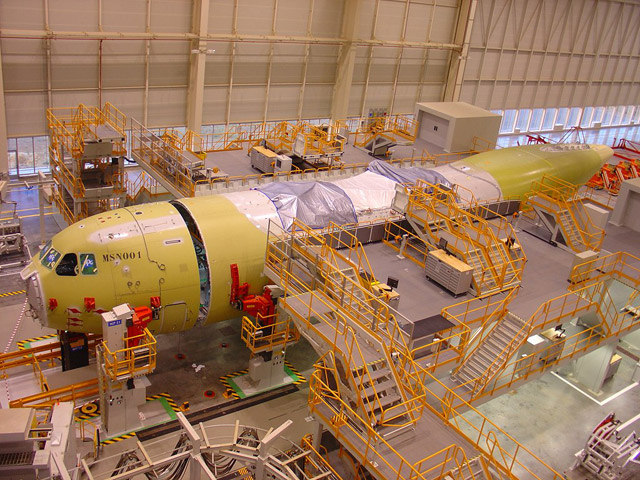“A VF-213 “Black Lions” Tomcat sits on the deck of USS Theodore Roosevelt, as the sun sets on the Tomcats distinguished thirty year career in the USN, So Long Baby” Man, what a great shot!
You need to activate Javascript in order to see this picture. If using a feed reader you need to visit the website.
Month: August 2007
Airbus A350 XWB with software-controlled high-lift flap
![]() The latest high-lift technology for the A350 XWB’s wing promises to reduce complexity and better deliver low-speed performance, while also offering significant fuel savings for airlines.
The latest high-lift technology for the A350 XWB’s wing promises to reduce complexity and better deliver low-speed performance, while also offering significant fuel savings for airlines.
High-lift systems use devices such as flaps and spoilers to create more lift from a wing, most notably during take-off and landing. While Airbus has generally been a leader when it comes to designing these mechanisms, the A350 XWB’s state-of-the-art system adds more intelligence to the wing, allowing for greater dynamic response and flexibility.
The new system integrates a wing’s flap and spoiler movements using a “software coupling.” Whichever way the flap may be deployed, the computer-controlled spoiler automatically moves into the most efficient position. Early wind tunnel tests on a modified A320 wing have proved the viability of a software-controlled spoiler-flap interlink, demonstrating an advantage in lift without any detriment in drag.
The new high-lift flap, which has been patented by Airbus, is a dropped hinge design and consists of a beam with a rotation point. Designated as the “advanced dropped hinge flap,” it is simpler than a conventional flap and requires less moving parts, resulting in a half tonne weight reduction. It is also easier and less costly to maintain. … [Full Article at airbus.com]
Adam Air 737 black boxes finally recovered
Almost 9 months after the Adam Air Boeing 737-4Q8 (PK-KKW) crashed into the sea near Sulawesi (Indonesia), the flight data recorder (FDR) and cockpit voice recorder (CVR) have been recovered. Both recorders have been retrieved by US company Phoenix International. The FDR was recovered on Monday Aug. 27 at noon and the CVR was recovered on Tuesday Aug. 28 at 10am, found not far from each other at a depth of around 1,800m.
The recorders will now be sent to the National Transportation Safety Board in the United States to determine the cause of the accident. Efforts to recover the so-called “black boxes” have been delayed for months due to disagreements over who should pay. Tatang Kurniadi, chairman of Indonesia’s National Transportation Safety declined to comment when asked who was paying the estimated $3m bill for recovering the recorders.
Indonesia is trying to improve its safety image after three aircraft accidents this year prompted the European Union to blacklist all of country’s airlines.
The US Federal Aviation Administration has also downgraded Indonesia’s safety rating to its lowest category.
The Adam Air Boeing 737 Flight 574 plunged into the ocean off the island of Sulawesi on January 1, killing all 102 people on board. The 17-year-old plane was heading from Surabaya in East Java to Manado in northern Sulawesi when it vanished in bad weather. The plane made no distress call, although the pilot had reported concerns over crosswinds.
Final assembly of first A400M begins
Closely following the assembly in July of the complete static test airframe in the static test facility in Getafe, near Madrid, assembly of the first Airbus Military A400M tactical transport production aircraft, MSN 001, has now begun in Seville.
With the main fuselage barrel and the nose fuselage section already in the jig at the final assembly line (FAL) site at San Pablo, Seville, and the wings and tail surfaces in situ, series production of the new airlifter can now be considered as having formally begun.
The first five aircraft to leave the FAL will be destined for the flight test programme and production at San Pablo will gradually increase to around thirty aircraft per year.


© Airbus Military
TAM Airlines Orders 1000th Boeing 777
Boeing today announced that an order from Brazil’s TAM Airlines for 4 additional 777-300ERs brings to 1003 the number of 777s ordered since the first order of the popular widebody in 1990. Today’s announcement also means that, to date in 2007, Boeing has received orders for 100 of the popular 777s.
TAM is Brazil’s largest airline, flying both domestic and international routes. TAM became the first Latin American airline to incorporate the 777-300ER into its long-range fleet plan when it booked its initial order for four 777-300ERs earlier this year. TAM’s first 777-300ER is scheduled to be delivered in June 2008. Prior to ordering these eight 777s, TAM was an exclusive Airbus operator.
“TAM’s recent orders confirm airline preference for the 777 family which commands more than a 65 percent market share in its category because of its lower operating costs, passenger pleasing cabin and unmatched reliability, ” said Larry Loftis, vice president, Boeing 777 Program. “We have continually enhanced and improved the performance of the 777 family of airplanes. Today, we have grown that family to include two, new, longer range 777s and a freighter version that will enter service in the fourth quarter of 2008.”
Marco Antonio Bologna, TAM’s CEO said the 777-300ER acquisitions are an important step for TAM’s growth in the long-haul international market. “The Boeing 777 provides TAM with unmatched revenue-generating capability, beginning with fuel savings and environmental benefits,” Bologna said. “Further, this is a plane long-haul passengers recognize for its spaciousness, comfort and award-winning interiors.”
The fuel-efficient 777-300ER is the world’s largest long-range twin-engine jetliner capable of carrying 365 passengers up to 7,880 nautical miles (14,594 kilometers). The efficient twin-engine design provides the lowest fuel consumption and overall operating costs in its class.
More than 380 patents for the A380
During the A380 development phase, Airbus filed more than 380 patent applications for technologies developed for the all new double-decker. Since the programme was launched in December 2000, these new technologies have been put through rigorous testing. Significant breakthrough innovations have been achieved in aerodynamics, cabin design, engine integration, flight controls, aircraft systems, manufacturing techniques and the extensive use of advanced lightweight composite materials, making the A380 the world’s most advanced and efficient airliner. These intellectual property rights secure Airbus’ innovations and form a solid basis for maintaining Airbus’ lead in new technological developments.
Among the innovations for which Airbus has filed patent applications is the Zero Splice inlet that is integrated into the A380 engines’ nacelles. This invention, which consists of a single 360 degree composite piece, instead of several separate panels spliced together, contributes significantly to the A380s very low noise emissions.
Another Airbus industry first is the extensive use of advanced lightweight materials, such as Carbon Fibre Reinforced Plastic (CFRP), for the large primary structures of the A380. Airbus has patented a new joining process for producing the world’s first ever carbon-fibre composite centre wing-box for a commercial aircraft. Some 25 per cent of the A380 structure is made of composites, generating a total weight saving of 15 tonnes, which contributes to its low fuel consumption and low noise emissions.
Airbus has also filed patents for the many innovative systems developed for the A380. These include the avionics data communication network (ADCN) which supports the increasing inter-system communication needs with the benefit of further improving data integrity and transmission speed. Another significant breakthrough in aircraft systems is the Brake-to-Vacate function that optimises the amount of energy used for braking and reduces runway occupancy time, while also ensuring a high level of passenger comfort during landing. Patent applications also cover the Electrical Back-up Hydraulic Actuator (EBHA) which is part of the A380’s new two energy, four-channel flight controls architecture. Conventional flight controls architecture on commercial aircraft has three hydraulic channels. The A380 architecture increases the performance and reliability of the flight controls system due to its dual energy source (electrical and hydraulic) and reduces weight by suppressing one hydraulic circuit.
These Airbus patented technologies will continue to be further improved during the service life of the A380 and a number of these have already been adopted for the A350 XWB. Innovation has always been an Airbus hallmark and the A380, about to enter service, definitely sets the standards for the 21st century.
Boeing Delivers 3000th Everett-built Widebody Airplane
Boeing today delivered its 3000th widebody airplane from its Everett, Washington, site. The airplane was a 777-200ER (Extended Range) model that was delivered to Korean Air.
The 3,000 airplanes built and delivered from the Boeing Everett factory include 747, 767 and 777 models. The site is celebrating its 40th anniversary this year.
“We are honored to receive the 3,000th airplane assembled at the Everett plant,” said J.H. Lee, president and COO, Korean Air. “Boeing Everett employees have made high-quality, reliable airplanes that have played a critical role in the success of our airline.”
The 3,000th airplane is joining the Korean Air fleet of 123 airplanes, which includes 13 777-200ERs, four 777-300s, 24 747-400s and 21 747-400 Freighters. Korean Air plans to use the new 777 for long-haul business routes to the Americas, Europe and the Middle East.

Korean Air also has 35 additional airplanes on order from the Everett programs including 777-300ERs, 777 Freighters, 747-8 Freighters and 787 Dreamliners. In addition, the airline has four 737s on order from the Boeing factory in Renton, Wash.
“This Korean Air 777 exemplifies the amazing accomplishments that have taken place at this factory over the past 40 years,” said Ross R. Bogue, vice president and general manager, 747/767/777 Programs and Everett site. “This milestone is a tribute to the hard work and dedication of our Boeing employees, suppliers and the community. Our focus on the customer enables us to produce airplanes that provide the highest levels of safety, quality, reliability and value.”
Over the years, the 3,000 widebody airplanes assembled at the Everett site have established a strong track record. Combined, the 747, 767 and 777 have completed more than 34.5 million flights through June 2007. They have logged approximately 148 million flight hours or nearly 17,000 years of flight time. The airplanes have flown approximately 71 billion nautical miles (131 billion kilometers), which is the equivalent of flying around the world 3.3 million times.
“We can all take great pride in the achievements these airplanes have made and continue to make,” Bogue said. “The Boeing 747, 767 and 777 are amazing airplanes with an unparalleled record of reliability, which is illustrated by the number of Boeing widebody airplanes in service today.”
Currently, more than 80 percent of the airplanes built at the Everett site — approximately 2,610 airplanes — are in service around the world.
The 3,000th-delivery milestone comes just nine years after the Everett site celebrated its 2,000th delivery — a 747-400 taken by British Airways May 15, 1998. The plant’s 1,000th widebody delivery was a 767-300ER delivered to Scandinavian Airlines on Aug. 14, 1989.
Boeing added the DC-10 and MD-11 airplanes to its widebody family in the 1997 merger with McDonnell Douglas. Deliveries of these widebody commercial airplanes totaled 586 when production ceased in 2000. However, these airplanes are not included in this milestone since none of those airplanes were assembled at the Everett site.
MAKS 2007 Photos
I collected some links to literally thousands of photos from MAKS 2007 International Aviation & Space Salon – Moscow (Russia), Zhukovsky Gromov Flight Research Institute. Enjoy!
http://maks.sukhoi.ru/maks2007.htm
http://maks.sukhoi.ru/maks2007_1.htm
http://maks.sukhoi.ru/maks2007_2.htm
http://maks.sukhoi.ru/maks2007_3.htm
http://maks.sukhoi.ru/maks2007_4.htm
http://maks.sukhoi.ru/maks2007_5.htm
http://picasaweb.google.ru/aviasalon.maks
http://pilot.strizhi.info/photos/v/MAKS-2007/
http://photo.strizhi.info/main.php
http://pilot.strizhi.info/category/aviation/maks-2007/
http://russos.livejournal.com/380237.html
http://russos.livejournal.com/379951.htm
http://russos.livejournal.com/379586.html
http://russos.livejournal.com/378992.html
http://russos.livejournal.com/377555.html
http://russos.livejournal.com/377218.html
http://russos.livejournal.com/376838.html
http://www.missiles.ru/foto_MAKS-2007_16-08.htm
http://00521.livejournal.com/30721.html
http://www.secretprojects.co.uk/forum/index.php/topic,2328.0.html
If you know some more links, please post in the comments!
A380 Charity Auction Starts 27 August
 The world’s first commercial flight of the A380 will take off from Singapore on 25 October 2007 and return from Sydney on 26 October 2007.
The world’s first commercial flight of the A380 will take off from Singapore on 25 October 2007 and return from Sydney on 26 October 2007.
Singapore Airlines will auction seats on both legs of the flight on eBay. All proceeds will be donated to charities.
The auction of seats on the First Flight will commence on Monday 27 August 2007. Seats in all three classes will be sold progressively, across both legs of the flight. Bids will be staggered to finish at various times over a period of just over two weeks, with the auction cycle being completed on 10 September 2007.
The auction will be for single, double and multiple seats in each class.
All seats will be sold on a one-way basis, so people wanting to fly on both legs of the First Flight will need to bid twice.
To participate in the auction, a bidder will need the following:
- An eBay user ID… it’s free and easy to get
- The names and passport numbers of those travelling
- For bids on packages in the premium classes (Business & Suites), or bids over USD1,000 in Economy Class, pre-qualification will be required. This ensures bids are not artificially inflated, and gives bidders confidence they are bidding only against genuine and pre-qualified bidders
Prequalification is initiated online. Singapore Airlines’ global auction management agency, Auctionwire, has developed numerous ways for bidders to pre-qualify and lodge security deposits for bids requiring pre-qualification.
Bidders will also receive a personalised certificate to commemorate participation in this historic event.
All information on packages available, bid prequalification and how to get an eBay user ID is available on the Singapore Airlines website, singaporeair.com/a380.
100% of the proceeds of the auction will be donated to charities. They are:
- One-third to Singapore’s Community Chest
- One-third split between the Sydney Children’s Hospital, Randwick, and The Children’s Hospital at Westmead, both in Sydney
- One-third to Médecins Sans Frontières, also known as Doctors Without Borders
Click here for more information: http://ebay.com.sg/SQ380
Boeing Converted Freighters Help Aeroflot Cargo Extend Life of MD-11 Fleet
The Boeing Company is helping Aeroflot-Cargo improve its operational efficiency and adapt to growing cargo market demands by converting two MD-11 passenger airplanes into freighters and updating their flight deck features and cargo-handling system so that they are consistent across Aeroflot-Cargo’s fleet.
“These aircraft represent a very substantial investment. By putting them in the hands of the original manufacturer for conversion, we can extend the life of the aircraft and maximize their capabilities,” said Aeroflot-Cargo General Director Andrey Goryashko. “The Boeing Converted Freighter program gives us the confidence and support that we expect with a new airplane while allowing us to make the most of the fleet we already have.”
A converted MD-11 has a capacity of 205,400-pounds (93.2 tones) structural payload at a range of 3,486 nautical miles (6,456 kilometers) and is capable of 630,500-pounds (286,000 kg) maximum takeoff weight. The main and lower deck cargo compartments hold a total of 36 96-by-125-inch pallets or containers.
“This conversion program allows Aeroflot Cargo to streamline and modernize its operational systems across its freighter fleet,” said Daniel da Silva, vice president for Sales and Marketing, Boeing Commercial Aviation Services.
Aeroflot-Cargo currently operates four DC-10 Freighters. In addition to these two MD-11s, Aeroflot-Cargo has committed to lease three more MD-11 Boeing Converted Freighters from the Boeing Capital Corporation within the 2007-2008 timeframe.
Modification work will begin in November 2008. Boeing Commercial Aviation Services will provide detailed engineering design work and oversight of the Aeroflot-Cargo conversions, with SASCO, a subsidiary of Singapore Technologies Aerospace, providing touch labor on the airplanes.
In total, Boeing has converted more than 100 MD-11 passenger airplanes to freighters.
